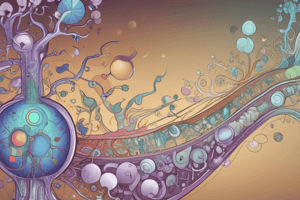Podcast
Questions and Answers
During which phase of glycolysis is more ATP produced than originally consumed?
During which phase of glycolysis is more ATP produced than originally consumed?
- Yield phase (correct)
- Investment phase
- Both phases produce equal amounts of ATP
- ATP production is not a part of glycolysis
How are atom balance and charges balanced in the glycolysis reaction?
How are atom balance and charges balanced in the glycolysis reaction?
- Atom balance is maintained by the release of CO2, and charges are balanced by the transfer of electrons
- Atom balance is maintained by phosphate groups contributing oxygen atoms, and charges are balanced by the difference between ADP and ATP (correct)
- Atom balance is maintained by the addition of water molecules, and charges are balanced by the exchange of protons
- Atom balance is maintained by the formation of NADH, and charges are balanced by the donation of electrons
What is the overall reaction of glycolysis?
What is the overall reaction of glycolysis?
- C6H12O6 + 2ADP + 2Pi + 2NAD⁺ $\rightarrow$ 2C3H4O3 + 2ATP + 2NADH + 2H⁺ + 2H₂O (correct)
- C6H12O6 $\rightarrow$ 2C3H4O3
- C6H12O6 + 2NAD⁺ $\rightarrow$ 2C3H4O3 + 2NADH + 2H⁺
- C6H12O6 + 6O2 $\rightarrow$ 6CO2 + 6H2O + Energy
What is the cellular environment tendency for ADP?
What is the cellular environment tendency for ADP?
What contributes to the overall hydrogen ion count in glycolysis?
What contributes to the overall hydrogen ion count in glycolysis?
What is the net ATP yield per glucose molecule in glycolysis?
What is the net ATP yield per glucose molecule in glycolysis?
What is the overall charge of ADP in the cellular environment?
What is the overall charge of ADP in the cellular environment?
How many oxygen atoms are contributed overall when each hydrogen phosphate anion binds to an ADP molecule during glycolysis?
How many oxygen atoms are contributed overall when each hydrogen phosphate anion binds to an ADP molecule during glycolysis?
What maintains atom balance in the overall reaction of glycolysis?
What maintains atom balance in the overall reaction of glycolysis?
How are charges balanced in the glycolysis reaction?
How are charges balanced in the glycolysis reaction?
Flashcards are hidden until you start studying
Study Notes
Glycolysis Overview
- Glycolysis is a metabolic pathway that converts glucose (C6H12O6) into pyruvate.
- Occurs in the liquid part of cells, the cytosol.
Energy Production
- Free energy released in glycolysis is used to form high-energy molecules ATP and NADH.
Characteristics
- Glycolysis is a sequence of ten reactions catalyzed by enzymes.
- Wide occurrence of glycolysis in other species indicates it is an ancient metabolic pathway.
Ancient Origins
- Reactions of glycolysis and pentose phosphate pathway can occur in oxygen-free conditions, catalyzed by metal ions.
- This is a plausible prebiotic pathway for abiogenesis.
Types of Glycolysis
- The most common type of glycolysis is the Embden–Meyerhof–Parnas (EMP) pathway.
- Discovered by Gustav Embden, Otto Meyerhof, and Jakub Karol Parnas.
- Glycolysis also refers to other pathways, such as the Entner–Doudoroff pathway and various heterofermentative and homofermentative pathways.
Studying That Suits You
Use AI to generate personalized quizzes and flashcards to suit your learning preferences.




